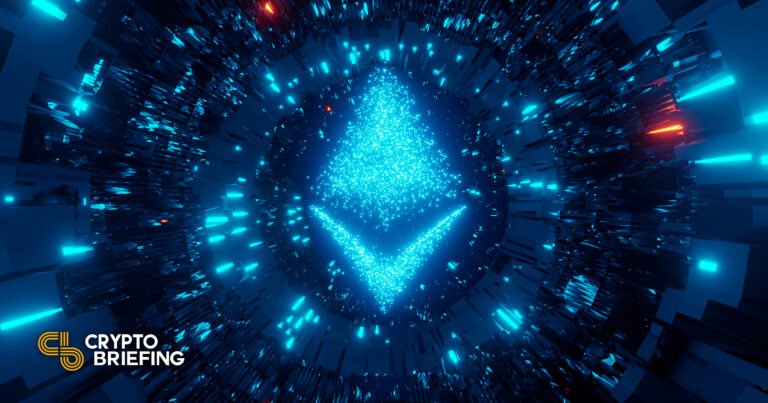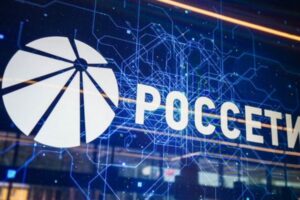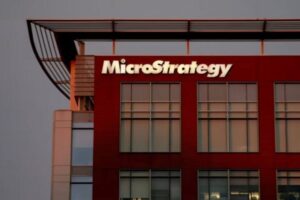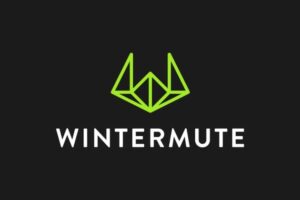
Key Takeaways
Several Ethereum Layer 2 projects could soon launch their own native tokens.
Arbitrum, StarkNet and zkSync have all hinted that launching their own token may be necessary to help them decentralize.
StarkNet has already confirmed that it will launch a token in the future, though no date has been announced.
Share this article
Several Ethereum Layer 2 networks have hinted that they could launch their own native tokens in the coming months, which would likely lead to airdrops for early users. Join Crypto Briefing as we take a look at which one could be the first to pull the trigger.
Arbitrum
One of the most eagerly anticipated Layer 2 tokens is that of Arbitrum, an Ethereum Optimistic Rollup solution created by Offchain Labs.
Arbitrum’s developers have been tight-lipped about whether or not the project will need a token, but several clues hint that one may be coming in the not-so-distant future.
Currently, Arbitrum’s transaction sequencing and proving are conducted solely by its creator, Offchain Labs. This measure was necessary for the early stages of the chain’s development to ensure stability, and has allowed Offchain Labs to react to fix issues when they arose.
However, now that Arbitrum has been up and running for over a year and completed its recent Nitro upgrade, Offchain Labs may soon start the process of opening the chain up to decentralized sequencing. The Arbitrum creator has frequently stated that its long-term plan will decentralize transaction sequencing to bring the Layer 2 more in line with the founding principles of Ethereum. However, ensuring that Arbitrum is both secure and decentralized is no easy task.
Many prominent figures in the crypto community have suggested that Arbitrum may launch a token to help collateralize and incentivize decentralized sequencing. The Layer 2 could reward sequencers with tokens for helping secure the chain, similar to how Ethereum mainnet issues ETH rewards to validators. There’s also scope for Offchain Labs to introduce a fee market where certain services require payment in Arbitrum tokens, creating a sub-ecosystem on the chain. Offchain Labs could also use a token for on-chain governance; however, since Offchain Labs is a registered company, it may be difficult for it to go down this route without falling foul of U.S. securities laws.
In recent months, Aribtrum has experienced an influx of users looking to register activity on the chain in hopes of receiving a token airdrop. Arbitrum’s closest competitor, Optimism, launched its own token in May this year, with both early and frequent users receiving a chunk of OP tokens for their patronage. The Arbitrum Odyssey campaign has further heightened speculation that an Arbitrum token may be in the cards. However, with little official information, it remains unclear if (and when) Arbitrum will launch a token.
StarkNet
While an Arbitrum token is currently only speculated, StarkWare’s StarkNet has already confirmed its plans to launch a token.
In a series of blog posts published in July, StarkWare announced that decentralizing its StarkNet Layer 2 network would involve issuing a token to be used as the network’s payment and staking asset. StarkNet is a Layer 2 network that utilizes Zero-Knowledge Rollups to help scale Ethereum.
Similar to how Offchain Labs currently handles all transaction sequencing on Arbitrum, StarkNet’s sequencing is also centralized. However, StarkWare intends to hand off transaction proving and sequencing to its community to make the network more secure and decentralized. The StarkNet token will be used in the network’s consensus mechanism both as staking collateral posted by sequencers and paid out as a reward to those who contribute to the network’s security.
Additionally, while StarkNet transaction fees are currently paid in ETH, StarkWare plans to switch fees to StarkNet’s native token after its launch. Once this takes place, a portion of the fees paid by users will also be redirected to stakers, just as they are on Ethereum mainnet. Allocating fees to stakers should continue incentivizing decentralized sequencing long after the maximum supply of 10 billion StarkNet tokens has been distributed.
A final planned use for the StarkNet token is in governance. Although StarkWare will maintain ownership of StarkNet, those who hold the network’s token will be able to help decide on its values and strategic goals through on-chain voting. The decisions token holders will have sway over has not yet been clearly defined. However, StarkWare has confirmed that token holders will need to approve major updates such as changes to StarkNet’s operating system.
Anyone looking to qualify for an airdrop of the StarkNet token is likely too late. According to StarkWare, the token launch has been designed to primarily compensate core contributors and developers. Half the token supply has been allocated to early investors, StarkWare employees and consultants, and StarkNet software developer partners. Of the remaining 50%, 9% has been set aside as a community provision.
Those who verifiably performed development work for StarkNet will receive tokens alongside previous StarkEx users who used the scaling project before June 1, 2022. This means that anyone who frequently used protocols such as dYdX, Immutable X, or Sorare could potentially qualify for an allocation.
While StarkWare has not yet confirmed a launch date, the July announcement said that the StarkNet token would launch in September 2022. However, while the contracts may go live within the next few weeks, it’s likely that tokens won’t properly enter circulation until a later date. That’s because most tokens will be locked and vested for at least one year from the StarkNet token genesis event. Anyone looking to invest in the StarkNet token will likely have to wait until community provisions are distributed at a later date before the market has sufficient liquidity to support trading.
zkSync
zkSync, another Zero-Knowledge Rollup project working to scale Ethereum on Layer 2, could also have a token in the works.
Since the early days of its development, zkSync’s development team Matter Labs has been transparent about its intention to launch a token. According to the project’s developer documentation, zkSync will launch a native token that will be required to help validate transactions on the Layer 2. Although no detailed information about how the token will be distributed and function has been released, zkSync will likely follow a similar path to StarkNet as both projects want to introduce a token to aid decentralization.
In terms of development, zkSync is ahead of StarkNet, having already launched a fully-composable Layer 2. Users can bridge funds to the zkSync 1.0 mainnet and participate in several activities, such as trading via ZigZag exchange, playing games on Tevaera, and donating to Gitcoin grants. However, the 1.0 version lacks features like Validium, which can offer off-chain data availability, higher transaction throughput, and lower fees.
zkSync is currently developing a 2.0 version that will incorporate Validium under the same zkSync API. zkSync 2.0 is currently in the testnet phase of development with a full release scheduled for October. If the 2.0 launch is successful, Matter Labs may shift its focus to decentralization, likely in the form of decentralized sequencing and a native token.
However, since Matter Labs is yet to release details on how it plans to decentralize zkSync, a token launch could be a long way off. As such, those looking to get in on a potential airdrop may still have time to get involved and register activity on the network. Using zkSync 1.0 is likely a good place to start; those who used it to donate to Gitcoin grants before a deadline were included in Optimism’s first token airdrop. Testing out zkSync 2.0 may also be worthwhile. Several DeFi and NFT apps have deployed contracts on the 2.0 testnet, so interacting with each of them could also help users qualify for additional protocol-specific airdrops.
So, Which Ethereum Project Could Be Next?
If StarkNet can stick to its September estimate, it will almost certainly be the next Ethereum Layer 2 to launch a token. However, due to the long vesting schedule of the initially distributed tokens, it may be some time before the StarkNet token community provision hits the market and provides sufficient liquidity for trading.
If this does end up being the case, token airdrops from Arbitrum or zkSync could eventually steal the limelight from StarkNet with wider allocations to their communities. Although neither project has made an official announcement, it doesn’t mean a token launch for either is necessarily that far away. Projects that are planning to airdrop tokens usually avoid announcing launch dates in advance to prevent Sybil attacks from airdrop farmers. In Optimism’s case, the project announced its token around a month before launch.
At their current development rates, Arbitrum or zkSync could surprise and launch their tokens ahead of a full launch from StarkNet. However, a token launch toward the end of 2022 or early 2023 seems more plausible. Either way, one thing is certain: Arbitrum, StarkNet, and zkSync have all committed to following Ethereum’s ethos and plan to optimize their networks for decentralization—and they’ll all need their own tokens to make that happen.
Disclosure: At the time of writing this piece, the author owned ETH and several other cryptocurrencies.
Share this article
The information on or accessed through this website is obtained from independent sources we believe to be accurate and reliable, but Decentral Media, Inc. makes no representation or warranty as to the timeliness, completeness, or accuracy of any information on or accessed through this website. Decentral Media, Inc. is not an investment advisor. We do not give personalized investment advice or other financial advice. The information on this website is subject to change without notice. Some or all of the information on this website may become outdated, or it may be or become incomplete or inaccurate. We may, but are not obligated to, update any outdated, incomplete, or inaccurate information.
You should never make an investment decision on an ICO, IEO, or other investment based on the information on this website, and you should never interpret or otherwise rely on any of the information on this website as investment advice. We strongly recommend that you consult a licensed investment advisor or other qualified financial professional if you are seeking investment advice on an ICO, IEO, or other investment. We do not accept compensation in any form for analyzing or reporting on any ICO, IEO, cryptocurrency, currency, tokenized sales, securities, or commodities.
See full terms and conditions.















